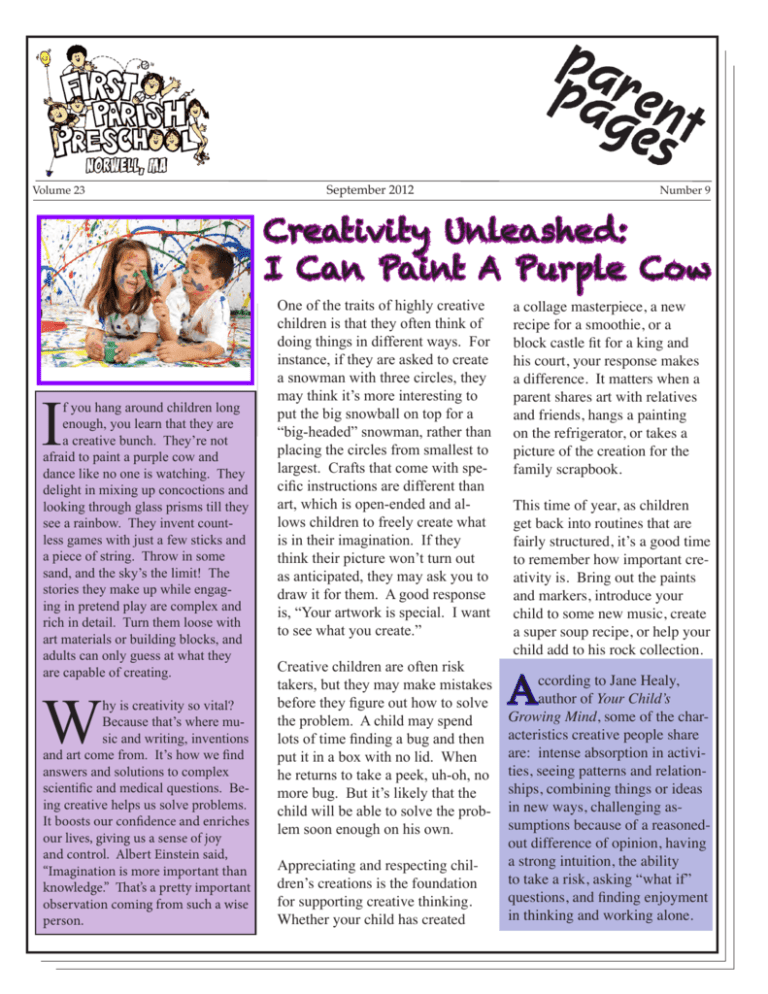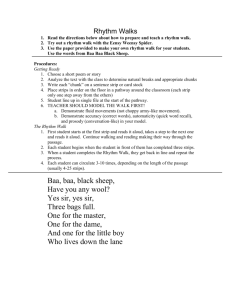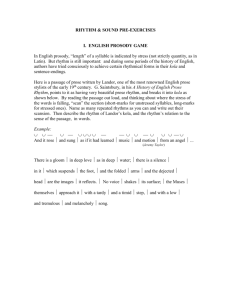Creativity Unleashed: I Can Paint A Purple Cow
advertisement

Volume 23 September 2012 Number 9 Creativity Unleashed: I Can Paint A Purple Cow I f you hang around children long enough, you learn that they are a creative bunch. They’re not afraid to paint a purple cow and dance like no one is watching. They delight in mixing up concoctions and looking through glass prisms till they see a rainbow. They invent countless games with just a few sticks and a piece of string. Throw in some sand, and the sky’s the limit! The stories they make up while engaging in pretend play are complex and rich in detail. Turn them loose with art materials or building blocks, and adults can only guess at what they are capable of creating. W hy is creativity so vital? Because that’s where music and writing, inventions and art come from. It’s how we find answers and solutions to complex scientific and medical questions. Being creative helps us solve problems. It boosts our confidence and enriches our lives, giving us a sense of joy and control. Albert Einstein said, “Imagination is more important than knowledge.’’ That’s a pretty important observation coming from such a wise person. One of the traits of highly creative children is that they often think of doing things in different ways. For instance, if they are asked to create a snowman with three circles, they may think it’s more interesting to put the big snowball on top for a “big-headed” snowman, rather than placing the circles from smallest to largest. Crafts that come with specific instructions are different than art, which is open-ended and allows children to freely create what is in their imagination. If they think their picture won’t turn out as anticipated, they may ask you to draw it for them. A good response is, “Your artwork is special. I want to see what you create.” Creative children are often risk takers, but they may make mistakes before they figure out how to solve the problem. A child may spend lots of time finding a bug and then put it in a box with no lid. When he returns to take a peek, uh-oh, no more bug. But it’s likely that the child will be able to solve the problem soon enough on his own. Appreciating and respecting children’s creations is the foundation for supporting creative thinking. Whether your child has created a collage masterpiece, a new recipe for a smoothie, or a block castle fit for a king and his court, your response makes a difference. It matters when a parent shares art with relatives and friends, hangs a painting on the refrigerator, or takes a picture of the creation for the family scrapbook. This time of year, as children get back into routines that are fairly structured, it’s a good time to remember how important creativity is. Bring out the paints and markers, introduce your child to some new music, create a super soup recipe, or help your child add to his rock collection. A ccording to Jane Healy, author of Your Child’s Growing Mind, some of the characteristics creative people share are: intense absorption in activities, seeing patterns and relationships, combining things or ideas in new ways, challenging assumptions because of a reasonedout difference of opinion, having a strong intuition, the ability to take a risk, asking “what if” questions, and finding enjoyment in thinking and working alone. Personal Parenting f Silly Voices, Happy Baby! If you lapse into a singsong, highpitched tone when communicating with babies, you’re not alone. Researchers have given this exaggerated “goo-goo, gaa-gaa” talk a name. They call it “motherese” or “parentese,” and it’s good for babies. This instinctive style of communication boosts learning potential. It also soothes crying––and what parent doesn’t want that ability in their bag of tricks? So, go ahead. In your best singsong voice, repeat over and over, “See the doggie. Do you see the doggie?” It simply means you’re a natural communicator, and babies pay attention! Cinnamon-Apple Breakfast Quesadilla 2 (6-inch) flour tortillas ½ cup chunky applesauce, divided ½ tsp. cinnamon ½ tsp. sugar ¼ cup shredded Cheddar cheese 2 Tbsp. yogurt Preheat the oven to 400 degrees. Place one tortilla on an ungreased baking sheet. Spread half of the applesauce on top. Mix the cinnamon and sugar together and sprinkle ½ teaspoon over the applesauce. Top with the cheese and the second tortilla. Sprinkle the remaining cinnamon sugar on top. Bake at 4oo degrees for 6 to 8 minutes, or until golden brown. Cut into quarters and serve with the yogurt and the remaining applesauce. C Relaxing with Children hildren get wound up from time to time. When you notice them getting rough and rowdy, anxious or uptight, try these relaxing techniques. Even very young children can learn to take deep breaths to calm themselves. Keep your voice quiet and ask children to hold a selected pose for a moment or two. Some of these poses are best done standing, and some work better when sitting or lying on the floor. For added fun, let your child make up a list for you. Pretend to be a . . . • leaf falling gently to the ground • balloon floating slowly in the wind • kitten sleeping in the warm sun • a yo-yo going up and down TV Turn-Off I t’s not healthy for kids to spend too much time in front of the TV. If they’re watching TV or engaged in other screen activities such as videos and digital games, they aren’t reading, socializing, playing outside, exploring, and creating. When watching TV, they’re also being bombarded with commercials, many of them for junk food and fast-food restaurants. Add to that violence and all kinds of other behaviors you don’t want your kids to model, and you have a great excuse for limiting TV and screen time. Healthy Eating Patterns It’s not always easy, but getting your child to be more adventurous at mealtimes has lots of benefits. Here are some strategies that will help. • Serve only one new food at a time. • Encourage, but don’t force, your child to taste each food. • Let children help shop for and prepare food— they’re more likely to try it and maybe even like it! • Remember that all children eat poorly at times. The key is to encourage a pattern of good eating habits. September 2012 www.parentpagesnews.com Inch-by-Inch Measuring Is a Cinch Simple math games are fun, and they’re guaranteed to enhance valuable skills. Set out an assortment of measuring devices such as a tape measure, ruler, yardstick, kitchen or bathroom scales, measuring spoons, and measuring cups. * How many pounds do the apples weigh? * How many feet from your bed to your bookshelf? * How many cups of flour go into the pancake batter? ISSN 1091-3173 © 2012 Pages Inc. • 1-719-685-0445 • Spanish by Silvia Uribe Creating a Rhythmic Lifestyle W hen you think of rhythm, what comes to mind? Strong beats of a drum, foot tapping to a marching band in a street parade, a fox-trot carried out with precision? These are examples of strong rhythms found in our society. The pattern is measured and predicted, producing a certain outcome. C reating a schedule and working together to make things happen is based on this principle of rhythm. It gets you in the swing of things. Simply committing to a set of routines that occur at the same time day in and day out can reduce many struggles within families. The goal is to make lifestyles more ordered, with far less confusion. And let’s face it, sometimes family life comes close to spinning out of control. Remember, children feel great security when routines are present and they know what to expect. A nalyze the day and determine where your family can benefit from smoother transitions. When and where are the rough spots encountered? When do things tend to fall apart? Whether you have a set schedule or one that varies from day to day, look for anchor points where you can build stability and strengthen family rhythms. O nce you’ve identified some times of day that can be more rhythmic, start slowly by picking one activity and attaching a routine to that one thing. There is no need to change everything at once. When creating a new routine, recognize that initially it may take more time instead of less. For example, having your child make her bed every day will initially take guidance and instruction from you. You have to show her how to do it, and you will have to remind her again and again. But eventually, the behavior of making the bed will become automatic. K ids who aren’t used to strong routines may at first be resistant. Keep at it anyway! Simply state that this is how we do it now, and don’t engage in arguments or negotiations. Within a couple of weeks, there will be an appreciation of knowing exactly what to expect and when. And remember, just like losing the beat of a song, you will occasionally get off course, but with a strong rhythm it’s easy to jump back in and find your spot. Time of Day Task that Promotes Rhythm Getting dressed for the day Lay out clothes the night before and get rid of clothing that creates battles. Prepare lunches ahead of time. Gather school items (jackets, backpacks) and place them by the door. Choose quick but nutritious food for breakfast. Keep the kids busy! Let them set the table, pour drinks, and clear the dishes. Choose specific nights for specific foods (Tuesday is pasta night, Wednesday is taco night). Most kids don’t need baths every day, so choose bath nights to correspond with nights when there are fewer activities. Follow the same routine every night. Light snack, brush teeth, book, and lights out. Weekends are trickier, but try to keep some consistency in the timing of things. Weekends may develop their own rhythm ––pancakes for breakfast, an evening walk after dinner. Getting out the door Preparing dinner Bath time Bedtime Weekends www.parentpagesnews.com September 2012





